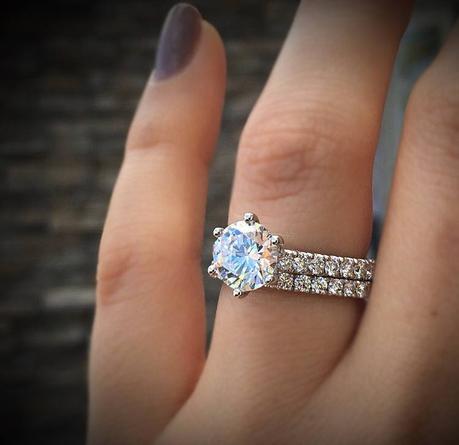What’s your favorite diamond shape? Mine is oval. No wait. It’s radiant. No – oval. Asscher maybe? Ok probably oval let’s stick with oval today. Anyhow, every girl’s got a favorite diamond shape (or two, three tops.) But do you ever wonder how price factors into your fave? What’s the most expensive diamond shape?

Shop Henri Daussi
As usual, with every and any question about engagement ring costs, the answer isn’t really straightforward. It depends on the diamond’s overall makeup – they’re so unique that each stone must be considered individually and evaluated on all of its facets (literally and figuratively) to come up with the grand total. The Wizards of Oz RapNet determine diamond pricing based on the 4 C’s, of course, but shape plays into the decision too. Why? The same reason that determines all economics: supply and demand.
When a diamond shape is hot hot hot, demand goes up and so does the price. Believe it or not (diamond monopoly conspiracy theories aside) there are a finite amount of 2 carat cushion cuts with G color, VS clarity and excellent cut grades. So the most expensive diamond shape changes with the bridal trends…to a degree.

Click here to shop
It shouldn’t surprise anyone that the number one spot almost always goes to the round brilliant. It’s classic, perennially popular, and always in demand. But that’s not the only reason. A polished diamond’s price also comes from how much of it was usable from the rough. So a polished diamond usually is about 40%-60% of the rough diamond it was cut from. And a round brilliant diamond, while gorgeous, creates the most waste from the rough, thanks to the way it’s cut. So they’re priced higher to make up for it.
When it comes to “fancy” shapes, aka any shape besides round, the prices drop – a lot. We’re talking 25% or more! Asscher cuts and Emerald cuts are priced higher because they’re rarer and require more attention to detail, respectively.

Click here to shop
Princess cuts are a great alternative to a round brilliant because their facets give them a similar amount of fire and brilliance. The way they’re cut reduces rough waste, so they’re a lot more affordable than an identical round brilliant.
After princess, cushion cuts and ovals are typically priced even lower. And because the demand is lower, price-per-carat rates on marquise, pears, and trillions usually falls even lower on the chart. However, prices are always in flux, and again – every diamond’s individual 4 C’s will determine its price, not just it’s shape.

Click here to shop
Just for kicks, here is an alternative breakdown of diamond price-per-carat, by shape, in descending order:
- Round (high demand, low return on rough)
- Heart (low return on rough)
- Asscher (rare)
- Pear (lower demand)
- Marquise and oval (lower demand, better return on rough)
- Emerald (lower demand, better return)
- Radiant (ditto)
- Cushion (high demand, but high return)
- Princess (ditto again!)

